How to Make an Ebook with 3 Free Tools
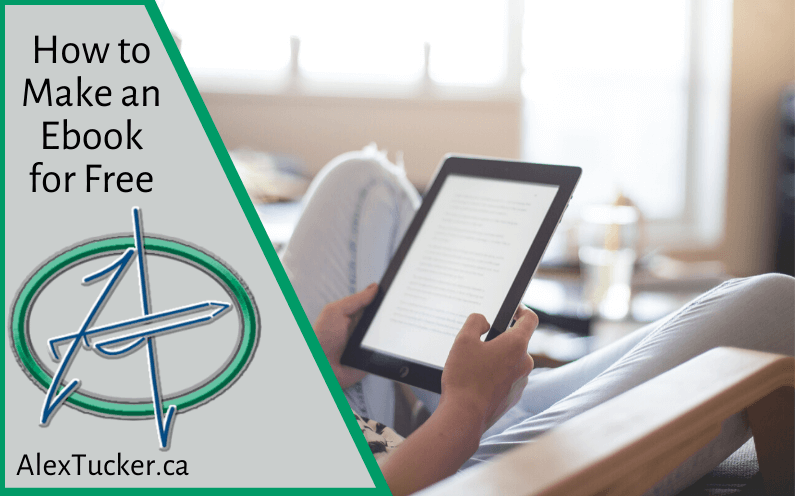
how to make an ebook for free
Need an ebook to use as a lead magnet for collecting emails? Here’s how to make one for free.
If you’re a blogger or an online business owner, you’ve probably heard the news; building an email list is important.
I may have understated that.
It’s very important!
Now that we’ve covered how crucial it is to build an email list, let’s discuss how to convince people to sign up.
You probably already know that you can use services like Mailchimp and MailerLite to get started with email marketing for free. They’re fantastic because they give you everything you need to gather and manage emails.
Except a motivator.
When was the last time you signed up for an email list just for the benefit of being on the list? I’ve done that a couple times, when I knew the person would send me valuable content or when I wanted to analyze their marketing strategy. But usually I sign up for lists because they offer me something.
That offer is known as a lead magnet. It can be literally any digital file that you can find a way to serve safely to the user, but the most common format is that of a free ebook/PDF.
Ebooks are easy to make for free, and they don’t have to be fancy in order to impress your readers; they just have to contain some great content.
They’re so easy to make in fact that this tutorial will contain two methods; the “quick-and-dirty” and the “slow-and-steady”. I recommend the second one, but the first will get the job done too.
For this tutorial we’ll be working primarily with Google Docs, but we’ll also use Canva.com and Google Slides in the second method to make enhanced PDFs. If you’ve never used these tools before, don’t worry; they’re all very user friendly and I include screenshots and instructions to help you along the way.
How to Make an Ebook for Free
The Quick-and-Dirty
If you need a PDF you can give away and you need it fast, you can get the job done using only Google Docs.
To access Google Drive and get started, log in to your Google/Gmail account and click on the nine grey dots in the upper right hand corner of the browser. This will open the apps menu, allowing you to click on Drive, shown below.
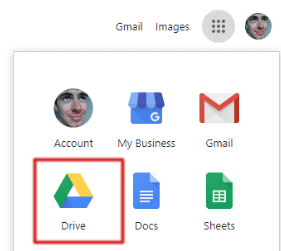
Once you’ve opened your Drive dashboard, click on the “New” button to the left, pictured above, and select “Google Docs”. This will open a fresh word processing document where you can create or paste the text and images for your PDF file.

Format it as you see fit and then click on File and select “Download — PDF Document” as shown below.

Et voila! You now have a perfectly serviceable PDF of your own design which you can give to your audience in exchange for their email addresses.
But… that’s not very fancy, is it? That’ll do if you’re really in a rush to get started, but if you want to develop an email list with hundreds or even thousands of followers… well, that’s what the next method is for.
The Slow-and-Steady
If you’re in it to win it, you’re probably looking to take the tortoise’s advice and do things properly. After all, slow and steady wins the race.
Thanks, tortoise.
If you want to make a fancier ebook using free tools, you’ll need to get creative and apply a bit more elbow grease, but it’s not that difficult. You can get started the same way!
Once you’ve written, edited, and formatted your document in Google Docs, rather than downloading it open a new tab and head over to Canva.com.
If you don’t already have a free Canva account, create one and then click on “Create a Design” in the upper left corner. You can select Magazine Cover to get started quickly, or Custom Dimensions if you have something special in mind. Magazine Cover will automatically generate an 8.5×11 inch document with many templates you can use to get started.
I managed to throw together a cover image for the ebook I’m going to make out of this post in about ten minutes:

Here’s a fun tip; you could actually build your ENTIRE ebook in Canva by clicking “Add a new page” as seen at the bottom of the image above. I prefer to use Google Docs for the document and just build my cover in Canva, but if you really like this tool there’s no reason not to use it for the entire process.
But assuming you want to use my method, download your cover image as a PNG. Head back to your Google Doc and put the cursor at the very beginning. Hit CTRL+Enter to add a page break. This will leave a blank page at the top of the document.
Now put the cursor back at the top and click on Insert and go to Image — Upload from computer, and upload the cover image you created in Canva.
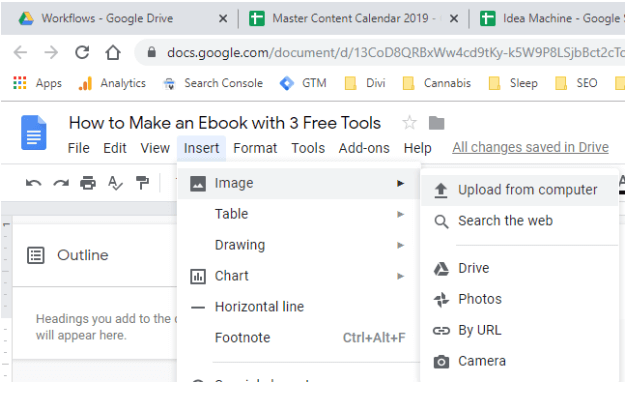
The image should already be an ideal size and properly aligned, but if necessary you can resize it and center it. You can also add a header and footer to each page of the document, and page numbers if you prefer. I like to create a header with the name of the document linking to the URL where it can be found online, and a footer with my name and a link to my personal website.
To add a header, footer, and page numbers click on Insert and go down to Header & page number, then select the element you want to add. Once these custom elements have been inserted, you can edit them the same way you edit other text in the document.
If you click on options to the right of “Header” it will open the following menu. Here you can customize the header and footer margins, and decide whether you want different information to display on the first page or on odd/even pages.

At this point, you should have a pretty professional looking document which you can download as a PDF and give away to your subscribers. I chose to include my author footer on my title page, but only put page numbers and the header on the body pages of the document.
But here’s the thing… what if you want to get really fancy? What if you want to play around with layouts, text and image placement, or create a colored document that’s a different size than 8.5×11 inches? Well, you already know how to do that in Canva… but personally I like to use Google Slides when I need to prepare a special PDF.
I usually use Google Slides for preparing custom reports or presentations for clients, but it’s a great software for making free PDFs if you have a decent eye for design.
The first couple steps for using Google Slides are the same as above; write up your content in a word processor such as Google Docs and prepare an appropriately sized cover image with Canva. Then create a new project in Google Slides when you’re ready to roll.
How to Make a Custom PDF in Google Slides
In your new Slides document, close the themes tab and then click on File — Page Setup. Click on the default size (which should be 16:9) in order to open a dropdown. If you don’t see the size you want, input custom values. 8.5×11 inches is the size of standard letter paper and most PDFs.
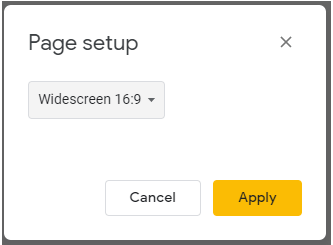
If you’re creating a presentation that you know will be given on a wide screen, then building a landscaped document has some advantages. But assuming the main value of your PDF will come from its text, I recommend using 8.5×11 inches. This is what most people will expect, and it is easily readable on all devices.
You can right click on the document to add background colors and images, and place text boxes and images of any size anywhere within the pages with the buttons shown below.

Slides doesn’t do nearly as much of the heavy lifting for you compared to Docs and Canva, but it offers a freedom which will be appealing to designers and people who are visually creative.
Here’s an example of a 16:9 cover page I created in about five minutes:

Notice how I’m able to include about twice as much data in more creative ways. If I had taken more time, I could have prepared a better Canva image and made this into something really special.
To add page numbers in Slides, click on Insert — Slide numbers. You’ll get the option to skip title slides (like I did) and to turn numbers on or off.
In order to create headers and footers, build the text box you want and then right click on it. Mouse over “Add to Theme” and then select “Master” if you want to add it to every page or “Title and Body” if you want it on all except the title page.
If you ever need to edit the text/images that you add to the master slide, just go to Slide — Edit master, and click on the master template as indicated below.
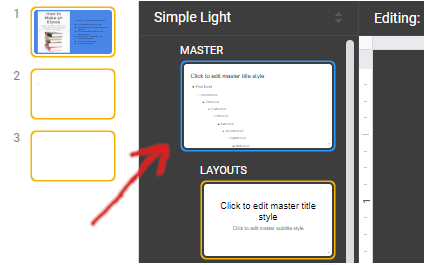
From there you’ll be able to access any elements that you added to the master slide.
Finish building your ebook, and then click on File — Download — PDF Document.
That definitely took a bit longer, but the end result with Google Slides is that you can customize virtually every aspect of the project. While Docs will probably suffice for the lion’s share of your free ebooks, Slides is a great option when you want to make something special.
So now you have a beautiful PDF which you made for free… but how can you get it to your subscribers?
How to Serve a PDF from Google Drive
Most online businesses will serve their free downloads to their users from a directory on their website, which is a great option if you have your own website. But if you’re on a free platform you probably don’t have server space to allocate for public downloads.
That’s one of the many beauties of your Google Drive.
Any file in your Google Drive can be shared via link or email. If you want to keep things private when you only have a few subscribers, you can add their emails manually as they sign up. But if you’re going to seriously scale your email list you’ll need a shareable link.
First create a new folder in Drive — call it “Free Downloads” or whatever you like. Upload your PDF to the folder and then right click on it.

Click on “Share” in the menu that opens, and then select Advanced.

Under “Who has access” click on Change… to open the link sharing screen:

Select “On — Anyone with the link” from the radio options, and “Can view” from the Access dropdown menu. Click save.
Back at the initial dialog, select “Prevent editors from changing access and adding new people” (this is a redundant measure in case someone gets editing permissions). Click save changes.

Now highlight and copy the “Link to share”. Put it somewhere you can access it easily, and include it in the body of the welcome email your marketing software sends out.
This isn’t a perfect method, because anyone with that link can view and download the document, but it’s a good enough system to get you started — and it’s free!
Final Thoughts on Making Free Lead Captures
Having a PDF or three to give away is bound to increase your optin rates, and you don’t even need to create customized documents for this purpose. You can just reformat your blog posts as PDFs, give them some fancy pants, and then make them available to your subscribers for free!
If you’re good at design and you DO create some really unique and attractive PDFs, you can even sell those online to supplement your other sources of income. This would require a more secure setup than just serving the files from Google Drive, but whatever shopping cart software you use would (probably) come with the ability to serve small files, or at least generate expiring links.


Hello Alex,
I have tried to download the PDF file of this blog post and I keep getting error messages. Could you please send me a link I can download from?
Hey Booky! Sorry for the trouble – I’ve been having some conflicts with my forms lately. I just set up and tested a new one that will give you access to my library of PDFs, you can find it here: https://alextucker.ca/social/